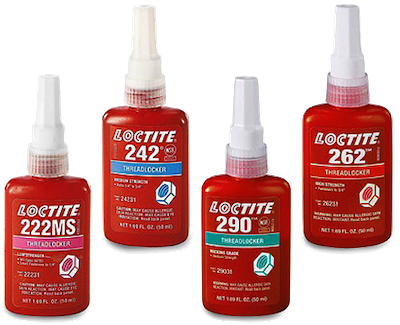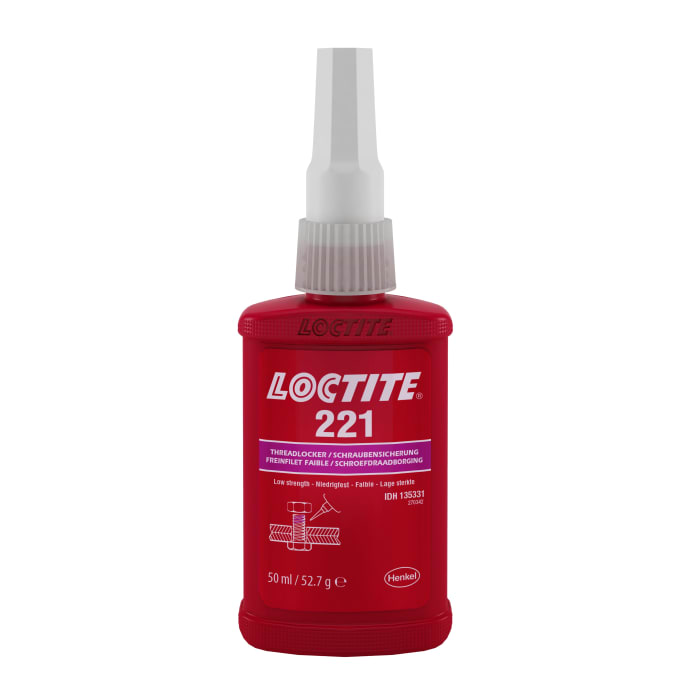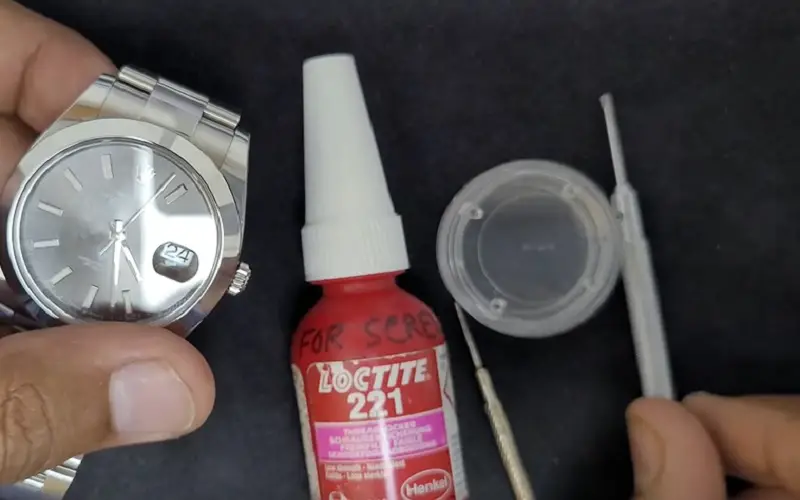Loctite 221 is a medium-strength threadlocker, while Loctite 222 is a low-strength threadlocker, with 222 offering easier disassembly. Both are anaerobic adhesives used for securing and sealing threaded fasteners.
When it comes to choosing the right threadlocker, the decision between Loctite 221 and 222 depends on the specific needs of the application. Understanding the differences and advantages of each product will help in making an informed choice.
Loctite 221 provides a medium-strength bond, making it suitable for applications that require a secure fastening with the possibility of disassembly using standard hand tools.
On the other hand, Loctite 222 offers a low-strength bond, facilitating easy disassembly, making it ideal for applications that require frequent maintenance.
Both products provide reliable sealing and vibration resistance, ensuring secure and durable fastening solutions.

Contents
Loctite 221 Vs Loctite 222
Features
When it comes to choosing the right adhesive for your projects, Loctite offers a range of products designed to meet specific needs.
Two popular options, Loctite 221 and Loctite 222, have distinct features that make them suitable for different applications.
In this section, we will explore the features of each adhesive to help you make an informed decision for your bonding needs.
Loctite 221 Features
- General Purpose: Loctite 221 is ideal for general purpose bonding applications where a medium-strength, fast-curing adhesive is required.
- Strength and Reliability: This adhesive provides excellent strength and reliable performance, making it suitable for a wide range of materials, including metals, plastics, and rubbers.
- Fast Cure: With its fast-curing formula, Loctite 221 sets quickly, allowing for efficient assembly and fast turnaround times.
- Temperature Resistance: It offers good temperature resistance, making it suitable for applications where exposure to heat is a concern.
- Versatility: Loctite 221 can be used in various industrial, maintenance, and repair applications, making it a versatile choice for a range of bonding needs.
Loctite 222 Features
- Low Strength: Loctite 222 is designed for applications that require a low-strength, easy-to-remove adhesive, making it ideal for securing small screws, nuts, and bolts.
- Removability: Its low-strength formula allows for easy disassembly of parts without the need for special tools, reducing the risk of damage during maintenance or repair.
- Threadlocking: This adhesive is specifically formulated for threadlocking applications, providing secure locking without the risk of parts getting stuck or seized.
- Small Parts Bonding: Loctite 222 is well-suited for bonding small parts in electrical and electronic equipment, offering reliable adhesion without causing damage or corrosion.
- Drip-Free Formula: Its low-viscosity, drip-free formula ensures precise application, making it suitable for delicate components and intricate assemblies.
Application Areas
Loctite 221 and Loctite 222 are two popular threadlocking adhesives with unique characteristics suitable for different applications.
Where To Use Loctite 221?
Loctite 221 is ideal for applications that require fast curing and easy disassembly, making it perfect for small fasteners or screws.
Where To Use Loctite 222?
Loctite 222 is designed for low strength threadlocking, primarily for adjusting screws, nuts, or bolts that need occasional adjustment or removal.
Strength And Performance
Strength Of Loctite 221
Loctite 221 is renowned for its exceptional strength and reliability. This adhesive is specifically designed to provide a secure bond for various materials, ensuring lasting results.
With a tensile strength of 12 N/mm², Loctite 221 is ideal for applications that require a medium to high strength bond.
Whether you are assembling small components or working on intricate projects, Loctite 221 can be trusted to deliver the durability your project demands.
To give you peace of mind, Loctite 221 offers excellent resistance to both moisture and temperature variations. This means that once your materials are bonded, they will remain secure, even in challenging environments.
Moreover, Loctite 221 provides quick fixture times, allowing you to move forward with your project with minimal delay.
Its excellent adhesion properties make it suitable for a wide range of applications, making it a versatile choice for both professionals and enthusiasts alike.
Strength Of Loctite 222
Loctite 222 is another adhesive renowned for its strength and performance. Developed to provide secure bonds, Loctite 222 offers a tensile strength of 4 N/mm². While not as strong as Loctite 221, it is ideal for lighter applications that require a reliable bond.
With Loctite 222, you can confidently fasten smaller screws and threaded connections, ensuring stability and preventing loosening due to vibrations. Its low strength makes it easy to disassemble if required, while still providing dependable locking for your components.
Like its counterpart, Loctite 222 exhibits excellent resistance to moisture and varying temperatures, ensuring the bond remains intact under challenging conditions.
Furthermore, Loctite 222 offers exceptional curing speed, allowing for quick project completion. Whether you are a professional or a hobbyist, Loctite 222 will provide the peace of mind that your materials will stay securely bonded, even in demanding environments.

Curing Time
Curing time is an important factor to consider when choosing a Loctite product for your bonding needs.
It refers to the amount of time it takes for the adhesive to fully set and reach its maximum strength. In this section, we will discuss the curing time of two popular Loctite products: Loctite 221 and Loctite 222.
Curing Time Of Loctite 221
Loctite 221 is a threadlocker adhesive that provides medium-strength bonding for fasteners. The curing time of Loctite 221 depends on various factors, including the type of materials being bonded, the temperature, and the humidity.
However, under normal conditions, this adhesive typically reaches handling strength in approximately 10 minutes.
After applying Loctite 221 to the threaded fasteners, it is recommended to allow it to cure for at least 24 hours before subjecting the assembly to full loads or immersion in liquids.
This curing time ensures that the adhesive has fully set and provides optimum strength for the bonded joint.
Curing Time Of Loctite 222
Loctite 222 is a low-strength threadlocker adhesive designed for fasteners that need easy disassembly.
The curing time of Loctite 222 is slightly different from Loctite 221. Under normal conditions, this adhesive reaches handling strength in approximately 15 minutes.
Similar to Loctite 221, it is important to allow Loctite 222 to cure for at least 24 hours before applying full loads or immersing the assembly in liquids. This curing time ensures that the adhesive has fully set and provides the desired level of bonding strength.
Both Loctite 221 and Loctite 222 offer fast curing times, allowing for efficient and reliable bonding. It is crucial to follow the recommended curing times to achieve the best results and ensure the longevity of the bonded joint.
Chemical Resistance
When choosing between Loctite 221 and 222, understanding their chemical resistance is crucial.
Resistance Of Loctite 221 To Chemicals:
Loctite 221 exhibits good resistance to various chemicals including oils, greases, and solvents.
Resistance Of Loctite 222 To Chemicals:
On the other hand, Loctite 222 is known for its exceptional resistance to chemicals such as acids and corrosive substances.

Temperature Resistance
When it comes to choosing the right threadlocker, temperature resistance is a critical factor to consider.
Both Loctite 221 and Loctite 222 are renowned for their exceptional performance under varying temperature conditions, making them popular choices for a wide range of applications.
Let’s delve into the temperature ranges for each of these threadlockers to understand how they stand up to heat and cold.
Temperature Range For Loctite 221
Loctite 221 offers impressive temperature resistance, making it suitable for use in demanding environments.
This medium-strength threadlocker can endure temperatures ranging from -55°C to 150°C (-67°F to 300°F), ensuring reliable performance in both extreme cold and moderate heat.
Temperature Range For Loctite 222
Similarly, Loctite 222 boasts excellent temperature resistance, providing secure bonding even when exposed to challenging temperature conditions.
This low-strength threadlocker is capable of withstanding temperatures between -55°C to 125°C (-67°F to 257°F), making it suitable for applications where moderate heat tolerance is required.
Frequently Asked Questions On Loctite 221 Vs 222
What Is Loctite 222 Used For?
Loctite 222 is used to secure small screws and nuts in place to prevent loosening. It is ideal for applications requiring low-strength threadlocking.
Which Loctite Does Rolex Use?
Rolex uses Loctite 221 for securing screws in their watches. This adhesive ensures the proper and long-lasting attachment of components.
Is Loctite 222 Removable?
Yes, Loctite 222 is removable.
What Is The Difference Between 222 And 222ms?
222 is a standard product, while 222MS has improved features for better performance.
Conclusion
Choosing between Loctite 221 and 222 depends on the specific needs of your project. Consider factors such as cure speed and strength when making a decision.
Both adhesives offer reliable performance, so selecting the right one will ensure a successful outcome for your application.

